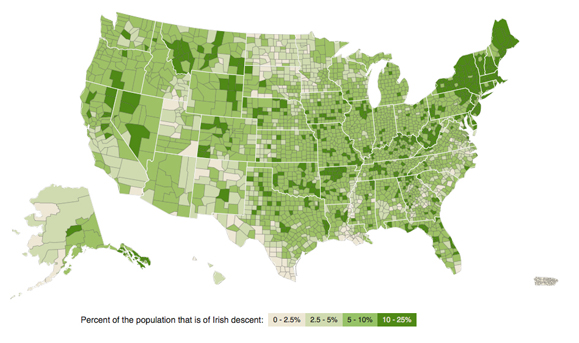The number of people in the United States who identify as Irish American has suffered a sharp decline in recent years and shows no signs of recovering just yet, according to the Pew Research Center’s “Fading of the Green” report released in May.
The population of Irish American residents, which stood at 36.9 million in 2009, dropped to 34.7 million in 2010, and by 2015 it had fallen to 32.7 million. In the last 15 years, there has been an overall drop of six million listings of Irish heritage. The percentage of the U.S. population composed of Irish Americans has decreased from 15.6 to less than ten.
The report lists several causes for the shrinking demographic, one of which is that as an ancestral group, the median age of Irish Americans (40.5) was older than that of the U.S. population as a whole (37.8). Also cited is an overall reduction in transatlantic immigration. In 2015, a mere 1,607 Irish-born emigrants obtained legal permanent residency.
The Pew Research Center has estimated that the recorded number of Irish Americans in the U.S. will drop below 30 million by 2020. However, it also calls on the United States’ Census organizers to allow Americans to fill out more than the currently-prescribed two countries of ethnic origin while filling out their details in order to allow individuals of diverse ethnic background to more accurately describe their roots.
The Vanishing Irish Americans


One factor that might help stem the decline is the advent of DNA services such as Ancestry DNA and 23 and Me that help people ascertain their ancestral roots. In my own case, I was adopted as an infant and did not know that I had significant Irish ancestry until last year when I purchased these tests (I am 55 years old).
That will not make one bit of a difference. TO be Irish, you must be an Irish national. So in order to be Irish American , no must be both Irish and American. No one outside the US base themselves on genetic or “blood”. Claiming to be Irish based on a great great grandparent that you knew little about and needed a DNA – Genealogy test to confirm it , won’t impress immigration at Dublin Airport . Likewise other European countries
If someone needs a DNA test to find out who they are, then that tells you that whatever link they might have had to another country is long dead.
Those DNA tests are highly questionable and are not remotely accurate. A lot of arm chair historians and genealogists scammers out there. One just has to look at the American based “genealogy” websites talking about the origins of well known Irish surnames and worse, the family crest.
“significant Irish ancestry”
Anything beyond Irish born grandparent is not significant
Sorry
Wow. Lots of hostility and hatred in the comment. Shows a real lack of understanding on how cultural communities in the United States formed.
This map is incorrect. The green areas you show in the deep south and out west, are Scottish people. These people are usually mis-labeled as Irish because of the Scots-Irish label. Scots-Irish are Scottish, not Irish. These were Scottish people who were transplanted to Northern Ireland by the Engish, before they finally came here to the U.S.
If you knew your history you would know that the three most populous Scots-Irish counties Antrim/Armagh/Down were never planted. The peoples of Scotland and Northern Ireland have had a fluid identity for millennia. Northern Ireland’s relationship with the Irish Republic has always been and will always be similar to that of Scotland and England, not because they were “planted” but because of cultural evolution.